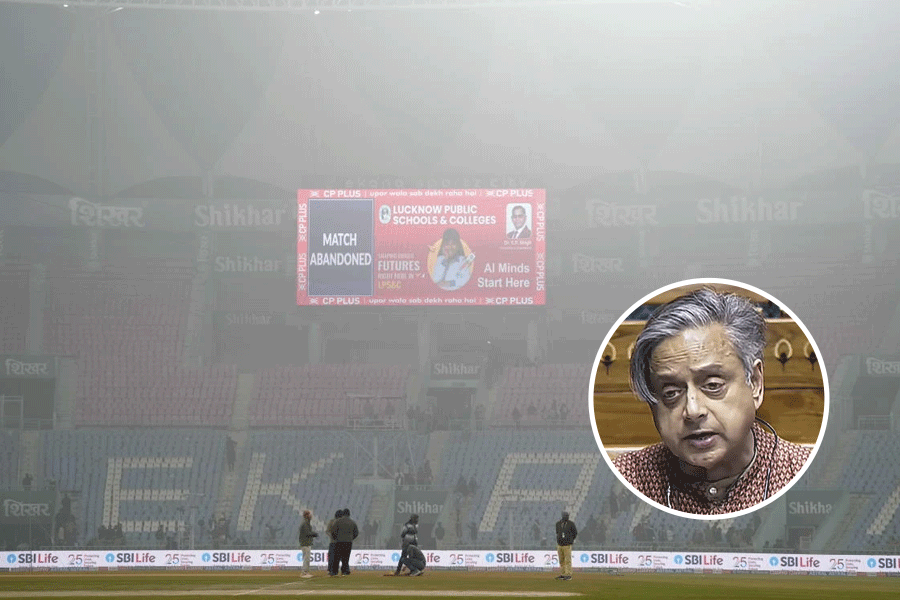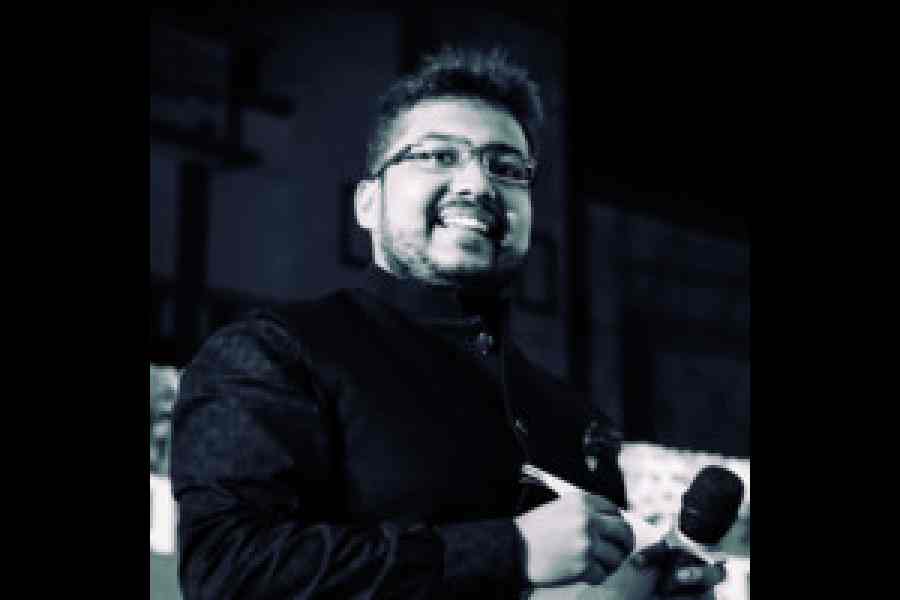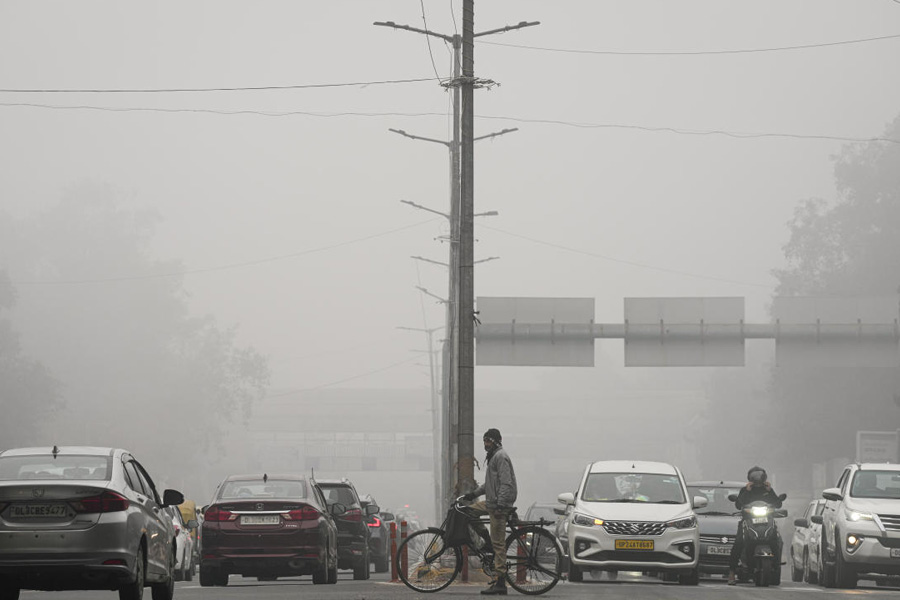 |
| Aahana Banerjee and Gour Chakraborty (centre) with Jayanta Chakraborty who transmitted the last telegram at 11.10pm on Sunday at the Central Telegraph Office. (Sanjoy Chattopadhyaya) |
The last few hours of the telegram in a city where it was born in India saw a thrilling contest on Sunday night that rivalled the first Ashes Test in competition and confusion over interpretation of the system.
Only, of the two claimants to the crown — the distinction of being the last sender from Calcutta — one worked silently while the other kept declaring her aim within everyone’s earshot for hours before.
Aahana Banerjee, a resident of Prinsep Lane, reached the Central Telegraph Office at 5pm with her father but let others precede her. “I wanted to be the last ever since I learnt a month ago that the telegraph service would stop on July 14,” said the first-time telegram-sender around 10pm.
Her father Ranjan Banerjee, who was to have a retina operation the next morning, was patiently seated nearby. “I am supposed to put drops in my eye every half hour but haven’t done so since 5pm as I want to be able to drive her back home.”
The daughter had returned home recently after completing her LlM from the UK. “I appreciate her sentiment,” he said, as Aahana plonked herself next to sub-divisional engineer (computer) Jayanta Chakraborty, who had been sending telegrams since 11.15am in the absence all operators who stayed away bowing to a staff union diktat.
The mass absence meant slow progress. Among the five officials present, only Jayanta knew how to run the web-based telegraph messaging system which transmitted telegrams. “My speed is not what it used to be when I was appointed nodal officer for implementing this technology and imparted training to our staff across Bengal. I am doing this job after nine years,” he said.
Gour Chakraborty, a philatelic dealer who had come to send four telegrams, reached the CTO around 12.30pm and waited in queue through a 10-minute lunch break and a server breakdown in the afternoon lasting another 10 minutes. “After my own telegrams were sent, I spotted some elderly stamp collectors standing in the long queue and felt bad. By then, I had seen so many telegrams being sent that I was confident that I had got the hang of the software,” he said. So he volunteered to help.
That meant Jayanta was free to accept bookings from a second machine in an adjoining room while under the supervision of senior superintendent, telegraph traffic, Sadhan Chandra Das, a nimble-fingered Gour carried on with the job.
But such was the pressure of work that even after his acquaintances left, Gour could not leave. Alerted by TV coverage of the historic day, more customers were walking in. The main gate had been closed at 5.25pm but in the absence of a gate-keeper, people sneaked in through the side entrance which is open round the clock because of BSNL’s guest quarters on the top floor. “Around 10pm, it occurred to me that since it was so late anyway, I could try sending the last telegraph myself.” There were still 33 people in the queue.
In the adjoining room, a huddle had formed around Jayanta with Mousumi Nandi, assistant general manager, customer services, trying to keep tabs on the cash collection. “I am feeling guilty. I am keeping my father waiting. Please don’t take a break,” Aahana pleaded, as Jayanta tried to stretch his legs.
Mousumi decided to collect all the remaining booking forms and put them in a serialised pile. “Please put mine at the end,” Aahana said, and marched out to tell her father of her triumph.
Thus Aahana’s form got the last serial number — A 277. Around 11pm, as the last half a dozen who had queued up around 7.30pm, took leave, the 27-year-old legal consultant took her seat next to Jayanta as press photographers focused on what they thought would be the picture of the last telegram being sent. She pumped her fist in triumph as he clicked the send button.
As she got busy posing for lensmen, Jayanta shut down machine No. 2 and went back to machine No. 1. “Sir, there are these two forms left,” said Gour and vacated the seat. Jayanta sent the last two in the pile.
As he was shutting the machine down at 11.15pm, in came Debashish Datta of Lake View Road from the side entrance. “Please let me send a telegram,” he begged. Exhausted at the end of the day, Jayanta referred him to Das, who had by now started counting the cash collection, signalling the end of the day’s business.
Once the machine was shut down, for the last time, at 11.40pm, Gour brought out the receipt of his last telegram, carrying the serial number A276. The time read 11.10pm, a clear seven minutes after Aahana’s telegram, in which she had written “Bharat bhagya bidhata”. Fate had run her out and stopped her from scoring the winning run.
Walking out of the building, Jayanta admitted that the time of transmission is what should be taken into account when deciding which the last telegram was, not the serial number. “I did not say this earlier as I did not want to break the girl’s heart,” he said.
Hearing the verdict, Gour, who was waiting outside, could not suppress his delight. “Few in the queue today can claim to have spent as much time with telegrams as I have. I think I have earned this.”
In a hurry then to catch the last bus home, he spoke to Metro again the next morning. “I used to assist veteran philatelic dealer Barun Dey for five years. He taught me about telegrams as collectibles. He bought 10tonnes of telegrams dated between 1925 and 1950 in an auction. It took me three months to sort them. People say telegrams are expensive at Rs 28.10. I have seen telegrams of the 1930s sent with Rs 25 stamps. Compared with that, the service cost a pittance in our times,” he said.
The man, who reached home at 12.45am, could not sleep till 2.30am in the excitement of achieving the feat. Asked what the message was in his last telegram, he drew a blank at first. “It had something to do with the telegraph ending after 160 years on July 14 midnight. I was filling up the form in a hurry in between accepting other people’s bookings,” he said a bit later.
Just as there is no record of the first telegram in India that was sent from Calcutta to Diamond Harbour, the text of the last message sent from the city remains shrouded in uncertainty. But unlike the unknown sender more than 150 years ago, Gour Chakraborty has etched his place in the city’s communications history.










